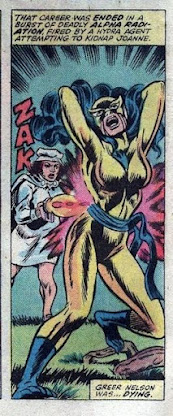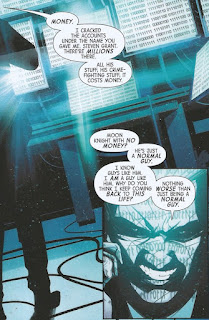Pick of the Brown Bag
November 11, 2021
by
Ray Tate
Tigra returns in Moon Knight number four. That addition to the series should be enough incentive for anybody to warrant a purchase. Let me sweeten the deal.
Steve McNiven and Frank D'Armata are the cover artists, but we all know the adage about judging a book.
Interior illustrator Alessandro Cappuccio details Tigra with care, bestowing to her the dignity she well deserves.
New Moon Knight writer Jed MacKay may enjoy Tigra as much as I do. For me, Tigra is love. She's my favorite Marvel character. However, for those who only like Tigra, never fear. Her guest-star status is quite apropos.
Tigra and Moon Knight share numerous aspects, in their biographies and their histories.
Both heroes appeared in Marvel magazines. Moon Knight starred in a backup feature for The Rampaging Hulk. An issue of Monsters Unleashed turned the spotlight on Tigra.
Moon Knight, like Tigra, is a designated protector. A fact reiterated in issue one when Moon Knight attacks a clutch of vampires.
This is also how Moon Knight acquires his vampire assistant Reese.
Reese is the kind of unexpected twist I've come to associate with Moon Knight's new writer Jed MacKay.
MacKay impressed me so much with The Black Cat, that I added Moon Knight to my subscription list before I knew Tigra would join the cast.
But back to the comparison.
Villains mortally wound the past incarnations of Tigra and Moon Knight. To escape death, both undergo metamorphosis.
Tigra for those not in the know is a seventies creation formerly known as The Cat, an alias for Greer Grant Nelson. She is the result of a somewhat successful super-soldier recreation.
Unfortunately, a HYDRA agent waylays the Cat. Through magic and science, a feline-humanoid species transforms Greer into their protector Tigra.
When a villain known as the Bushman murders Marc Spector, he falls under the shadow of Khonshu, a mythological figure from the Egyptian pantheon. It appears that Khonshu resurrects Marc Spector. Though co-creator Doug Moench is never explicit.
Moench never originally developed Moon Knight as a priest for Khonshu. He instead turned Moon Knight into a reflection of the Shadow. Moon Knight juggled three different personae: his base Spector, depicted above, correlates with the Shadow's true identity Kent Allard.
Steven Grant, name-checked in the current issue, agrees with the Shadow's assumed identity Lamont Cranston. His third personality cabdriver Jake Lockley alluded to the Shadow's cabbie operative Shrevvy.
These identities fell by the wayside when Moench left the series. Other writers including Tigra-hater Brian Bendis gave Moon Knight a whole slew of new/old faces.
Warren Ellis and Delclan Shalvey straightened a lot of this conflicting history out in a recent volume of Moon Knight.
Ellis/Shalvey for example created Mr. Knight. A more relatable detective. A kind of masked Amos Burke who interacts nicely with the police. MacKay uses this facet to be the welcoming, civil guise of Moon Knight.
MacKay explicitly states that Mr. Knight is "the High Priest of Khonshu," and that the travelers of the night are his congregation. These tourists fall under Moon Knight's aegis, even vampires.
At the same time, MacKay pokes fun at the idea of Moon Knight being a Priest of Khonshu. Marc's dead serious about the designation, but he approaches the role with a lighter touch.
Certainly, incantations are not necessary, neither is worship. Rather, Moon Knight serves those who inhabit the evening. It's not the other way around. In a way, MacKay slyly uses Moon Knight to skewer religious hubris. For example, lots of "good" Christians hate the LGBT community. No really good Biblical reason. They just exploit religion to pardon their hate.
Moon Knight does not distinguish the traditional monster from those he protects. I wouldn't be surprised if MacKay chose vampires not for just practical reasons but also for their LGB symbolism. Before anybody asks, sure you can have trans-vampires. I suppose since vampires originate in Transylvania, you must.
I just haven't seen any examples of such in pop culture. It would be easy. A vampire just needs to take a bite out of a trans-person. Boom. Trans-vampire, or Transpire.
Maybe you're concerned Moon Knight, with his clunky history, will be a little too involved for you to appreciate. MacKay employs several techniques that allow for smooth reads. MacKay doesn't ignore any of Moon Knight's history. He just chooses to follow what makes sense. The other portions he pays lip service to, or he creatively uses them as elements in his story.
Each issue of MacKay's comic books has a beginning, middle and an end. The tales are in general stand-alone, occasionally two-parters, but they don't on average go beyond that.
In issue one Moon Knight encounters the vampires as well as some other creatures of the night. In issue two, he deals with somebody that controls minds. In issue three, Moon Knight faces his opposite number. In four, Tigra pops in and together they fight a simple crook who has delusions of grandeur. MacKay carries over themes within the stories: the vampire angle, Marc Spector's therapy sessions, Moon Knight's status as a High Priest.
I hesitate to say its continuity, for in comic books, that takes on a new meaning. Rather, MacKay recreates the consistency of a comic strip and he explains things cleverly without needless exposition for that issue. He furthermore doesn't repeat himself. He finds new ways to introduce the same information. So, if you start with the current issue of Moon Knight, you'll understand why Reese is a vampire and Mr. Knight's assistant. If you read the rest of the series, you'll receive story elements under a deeper context.















No comments:
Post a Comment